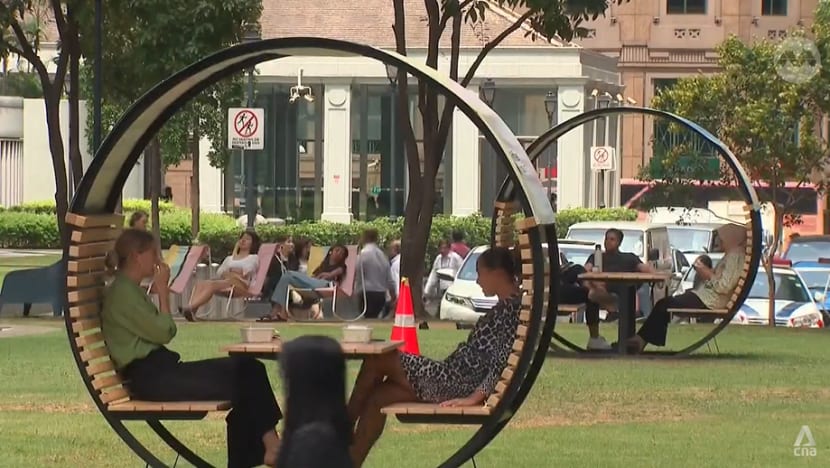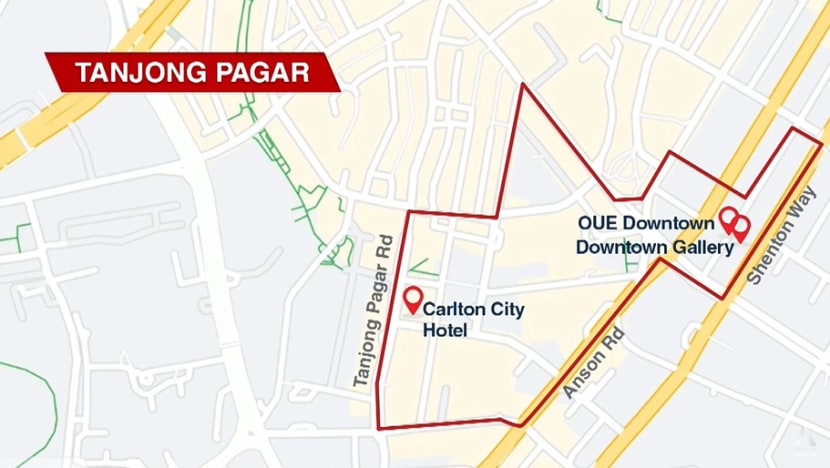Tanjong Pagar, Raffles Place among areas seeing success from ground-up initiatives to enliven precincts
Being part of a pilot Business Improvement District (BID) means members join and fees are collected to fund ground-up projects and events.

Such seats are part of how the Raffles Place Alliance has enlivened the area.
This audio is generated by an AI tool.
SINGAPORE: Business has been booming for some restaurants in Tanjong Pagar, thanks to their own initiative.
The shops, hotels and restaurants in the area - from Tanjong Pagar Road to a part of Shenton Way - have banded together to make the place more vibrant, as it is part of a pilot Business Improvement District (BID).
Being part of the programme means members join and fees are collected to fund ground-up projects and events. The government will match these fees up to S$500,000 (US$673,000) each year.
Some eateries told CNA that their tills have been ringing more as increasing numbers of people, including tourists, visit the area for a meal.
“We've actually recently expanded - we've opened a new sister outlet right across Maxwell station,” said Ms Rich Jacob, operations manager at Kafe Utu, which serves African food.
She noted that there has been a 10 to 20 per cent increase in footfall on weekdays, with even more on weekends.
Residents in the nearby neighbourhood have also benefitted, with money used to spruce up common areas.
IMPROVEMENTS IN DISTRICTS
Surveys have also found a 10 to 20 per cent increase in footfall since the precinct joined the pilot programme, said Ms Patrina Tan, co-chair of Discover Tanjong Pagar, the group driving its improvement.
One of the appeals of the area is its greenery, including an eco-playground that was conceptualised along with the community, she added.
“What we're trying to do is to ensure that we continue to put in place amenities that the residents find relevant and (that they are) able to spend more time out of their house than just being cooped up,” she said.

She added that there is a push to bring in different types of businesses to the area, for fear that there are too many eateries. The area has already earned the reputation of being a little Korean town, for the number of Korean eateries it houses.
The BID will also bring in more retail, lifestyle and wellness offerings and events. It will also act as a satellite location for sustainable light festival i Light Singapore next year, said Ms Tan.
Another BID is Raffles Place, covering areas along Church Street, all the way to a part of Boat Quay. Among the changes are benches to offer people a place to unwind.
The BID's representative Sharon Teo said the challenge is keeping the place buzzing even after work.They have been organising regular workout sessions, lawn games, picnics, live music and mural painting.

Efforts have paid off so far, said Ms Teo, chairperson of Raffles Place Alliance, citing a recent event that more than 4,000 people attended.
“With the increased footfall and visitorship, we are also seeing an increase in F&B (food and beverage) … That is certainly having the snowball effect over the past years to now,” she said.
Ms Teo, who is also managing director of workspace management at CapitaLand Investment, added that the precinct has also attracted a greater mix of F&B outlets, which has been attracting consistent visitorship.
SOME DISTRICTS DID NOT TAKE OFF
Raffles Place and Tanjong Pagar are among the original nine precincts announced in 2018.
Along with Marina Central and Singapore River, they have extended their status for two more years with the government. The other five, which include Jurong Gateway, China Place and City Hall and Paya Lebar Central, did not do so.
CNA understands COVID-19 was one reason some BIDs failed to take off.
Dr Tan Wenn Er from National University of Singapore’s Faculty of Arts and Social Sciences said that many factors can be involved in why some BIDs fail and others thrive.
“One thing to keep in mind is whether the different stakeholders can really come together and have the shared cohesive place identity,” she told CNA’s Singapore Tonight.
“That said, I think, BIDs are really a tool for precincts to use and so it's very normal for some places to realise that this is not quite the policy for them.”
Despite the lack of success of some BIDs, the Urban Redevelopment Authority said the pilot programme has resulted in greater ownership and collaboration among stakeholders to enliven their precincts through various initiatives.
It cited the Singapore River Festival organised by Singapore River One stakeholders, the eco-playground in Tanjong Pagar, and Raffles Place Alliance working with the National Parks Board to hold movie screenings at the Raffles Place Park.
“We see value in continuing the programme to foster stronger partnerships between the stakeholders and government agencies to co-create vibrant and distinctive destinations,” the URA told CNA.
It added that it will continue to facilitate and guide pilot BIDs to come up with plans.











